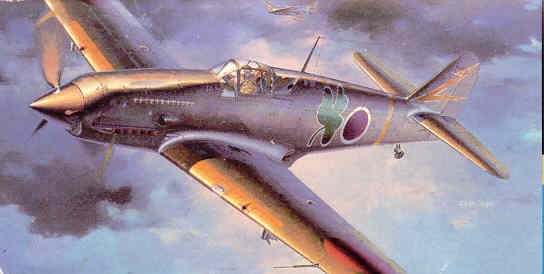
Hasegawa 1/48 Ki-61 Hein
|
KIT # |
9012 (JT 12) |
|
PRICE: |
@$25.00 MSRP |
|
DECALS: |
See Review |
|
REVIEWER: |
|
|
NOTES: |

|
HISTORY |
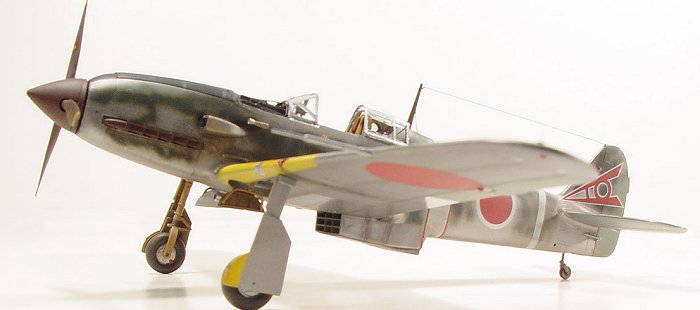
When first seen in the
Pacific Theater of operations, Military Intelligence thought the new sleek
menace was a licensed version of the magnificent Messerschmitt Bf-109E
which was known to be in Japan at that time. In reality it was a
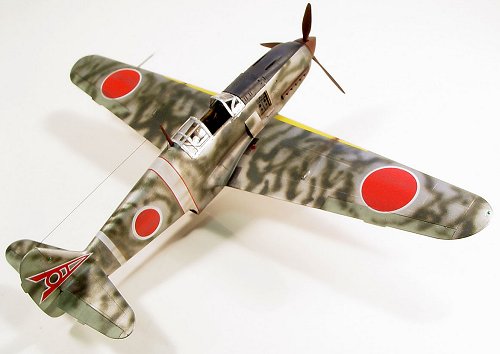 very brash
attempt by the Japanese Military Industry to improve on the German fighter.
It was first given the name of “Mike” when it was thought to be a
Messerschmitt. Then it was thought that the design was a modified Italian
aircraft, so it was given the name “Tony”. It wasn’t until the aircraft was
photographed on Rabaul that the United States realized that they had a
whole new aircraft on their hands.
very brash
attempt by the Japanese Military Industry to improve on the German fighter.
It was first given the name of “Mike” when it was thought to be a
Messerschmitt. Then it was thought that the design was a modified Italian
aircraft, so it was given the name “Tony”. It wasn’t until the aircraft was
photographed on Rabaul that the United States realized that they had a
whole new aircraft on their hands.
When it was confirmed it was a new type not seen before, the code name “Tony” had already stuck. The Japanese Army called it a Kawasaki Ki-61 “Hien”. It was the only mass produced liquid cooled inline engine Japanese fighter during the entire war. The Japanese Army never worked all the bugs out of the Ha.40 inline liquid cooled powerplant and a version of this airframe incorporated a radial engine turning it into the exceptional Ki.100. The fighter was used extensively in the Philippines and New Guinea area and was one of the main interceptors trying to stem the inundation of B-29s over the Japanese Homeland. Many B-29s fell pray to the lustrous fighter. Many consider the Ki-61 series to be Kawasaki’s definitive product during Japan’s conquest of the Pacific.
|
THE KIT |
This is without a doubt my favorite Japanese aircraft. It is a very sleek and very colorful aircraft for a sometimes very uninteresting Japanese Army paint schemes. It is molded in a dark gray high quality plastic with no flash. The decals and canopy are wrapped in their own bag. Very well packed but you would not expect anything less from Hasegawa. The decals seem a bit thick and the white has already yellowed a bit. The box art is gorgeous as usual.
|
CONSTRUCTION |
 I purchased an Aries resin and photo-etch
cockpit to spice the kit up a bit. The resin is cast in a crème color and
has no pinholes or warping. It comes complete with a full set of machine
guns and a detailed firewall. If you sought to put a modified DB-601 engine
in it would be an easy modification. I decided to display the aircraft with
the machine gun cover and ammo boxes uncovered. If you do the same you will
need to cut the deck out that is in front of the cockpit windscreen. This
weakens the front of the fuselage so you need to be careful and not warp
the fuselage halves during assembly. As usual, trial and error is the
mantra of the day. The interior was painted a strange kind of tan known as
Kawasaki Interior Tan. The best equivalent I found was Model Masters Acryl RLM 79 with a soft black wash to bring out highlights and detail in the
cockpit. I had to sand down the sides of the fuselage a little bit and
trial fit the deck behind the headrest many times. Everything in the
cockpit area got a coat of the tan with the exception of the machine gun
area and engine bay area. That was painted flat black.
I purchased an Aries resin and photo-etch
cockpit to spice the kit up a bit. The resin is cast in a crème color and
has no pinholes or warping. It comes complete with a full set of machine
guns and a detailed firewall. If you sought to put a modified DB-601 engine
in it would be an easy modification. I decided to display the aircraft with
the machine gun cover and ammo boxes uncovered. If you do the same you will
need to cut the deck out that is in front of the cockpit windscreen. This
weakens the front of the fuselage so you need to be careful and not warp
the fuselage halves during assembly. As usual, trial and error is the
mantra of the day. The interior was painted a strange kind of tan known as
Kawasaki Interior Tan. The best equivalent I found was Model Masters Acryl RLM 79 with a soft black wash to bring out highlights and detail in the
cockpit. I had to sand down the sides of the fuselage a little bit and
trial fit the deck behind the headrest many times. Everything in the
cockpit area got a coat of the tan with the exception of the machine gun
area and engine bay area. That was painted flat black.
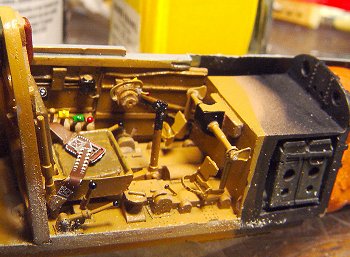 The resin cockpit went
together with no problem and looked great assembled. Use the kit
instructions to paint all the different levers and knobs their proper
color. The instrument panel is the photo film type with the photo-etch
panel. Paint the back of the clear film white and then use a drop of Future
Floor Wax to glue the film to the back side of the instrument panel. The
Future allows you extra time to get the instruments aligned up perfect and
gives a glassy look to the different instruments. A set of Eduard seatbelts
finishes off the cockpit nicely. Don’t install the gunsight until the end
of the build or you will loose it during sanding. Just follow the
instructions and you will be done in no time.
The resin cockpit went
together with no problem and looked great assembled. Use the kit
instructions to paint all the different levers and knobs their proper
color. The instrument panel is the photo film type with the photo-etch
panel. Paint the back of the clear film white and then use a drop of Future
Floor Wax to glue the film to the back side of the instrument panel. The
Future allows you extra time to get the instruments aligned up perfect and
gives a glassy look to the different instruments. A set of Eduard seatbelts
finishes off the cockpit nicely. Don’t install the gunsight until the end
of the build or you will loose it during sanding. Just follow the
instructions and you will be done in no time.
I assembled the lower radiator and grill.
Then paint the radiator flat black with a dry brushing of silver to pick
out the detail in that area. There is a faring that goes behind the
radiator that you shouldn’t forget once I was happy with the fit of the
resin interior I glued the two fuselage halves with my
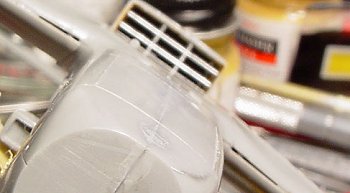 favorite welding
torch. Tamiya Liquid Cement. I left the top engine cover and machine guns
off until final assembly. I sat the fuselage off to the side and started on
the wings. In order to get the fuselage to meet the upper wings I glued the
upper wing sections onto the fuselage wing roots. Then I fitted the one
piece bottom wing section to the fuselage bottom and upper wing parts. This
caused large gaps in the front edge of the wing roots but made the cord of
the wing fit against the fuselage much better. All of these areas would be
filled with Tamiya Putty. The landing light area was painted flat black
with a small disk of Bare-Metal-Foil to represent the light. Then the lens
favorite welding
torch. Tamiya Liquid Cement. I left the top engine cover and machine guns
off until final assembly. I sat the fuselage off to the side and started on
the wings. In order to get the fuselage to meet the upper wings I glued the
upper wing sections onto the fuselage wing roots. Then I fitted the one
piece bottom wing section to the fuselage bottom and upper wing parts. This
caused large gaps in the front edge of the wing roots but made the cord of
the wing fit against the fuselage much better. All of these areas would be
filled with Tamiya Putty. The landing light area was painted flat black
with a small disk of Bare-Metal-Foil to represent the light. Then the lens
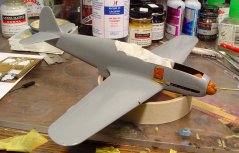 was fitted and sanded to shape, polished and masked off for protection. I
built a small 90 degree “T” jig to get the tail planes level and then glued
them in place. It was looking like a plane already! I painted the landing
gear legs and covers tan along with the small wheel covers and linkage. A
small band of Bare-medal-Foil simulated the oleo strut. The radiator flap
got put on next. It looks much like those on a P-51 and serves the same
purpose. I sanded all seems and joints making sure to polish out any
scratches or blemishes that will show up under the silver paint. A bit of
Mr. Surfacer here and there and the plane was ready for masking and
painting.
was fitted and sanded to shape, polished and masked off for protection. I
built a small 90 degree “T” jig to get the tail planes level and then glued
them in place. It was looking like a plane already! I painted the landing
gear legs and covers tan along with the small wheel covers and linkage. A
small band of Bare-medal-Foil simulated the oleo strut. The radiator flap
got put on next. It looks much like those on a P-51 and serves the same
purpose. I sanded all seems and joints making sure to polish out any
scratches or blemishes that will show up under the silver paint. A bit of
Mr. Surfacer here and there and the plane was ready for masking and
painting.
|
CAMOUFLAGE & MARKINGS |
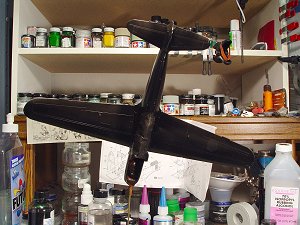 I like to use Alclad II for all my silvers
now. I picked up a new bottle of Alclad Primer Black and shot the plane
completely. It was very strange to see the plane in gloss black but that is
what Alclad calls for (Your editor should point out that it is only
required for the very shiny colors such as bright chrome or polished
aluminum).
I like to use Alclad II for all my silvers
now. I picked up a new bottle of Alclad Primer Black and shot the plane
completely. It was very strange to see the plane in gloss black but that is
what Alclad calls for (Your editor should point out that it is only
required for the very shiny colors such as bright chrome or polished
aluminum). 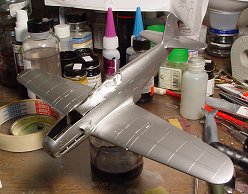 Now it was time to shoot the entire plane with Duralum Silver. Don’t forget to paint the wheel spats and the small wheel
covers while you have the airbrush loaded up. While the silver was drying I
moved to the prop and spinner. It assembled easily but the back of the
spinner could fit a bit better to the nose of the spinner. They got a shot
of a special dark brown mix made from Model Masters Acryl Rust and Flat
Black. Remove the masking tape from all control surfaces. After the plane
was completely dry I masked off all flight controls then sprayed all the
control surfaces Tamiya IJN Gray. You
Now it was time to shoot the entire plane with Duralum Silver. Don’t forget to paint the wheel spats and the small wheel
covers while you have the airbrush loaded up. While the silver was drying I
moved to the prop and spinner. It assembled easily but the back of the
spinner could fit a bit better to the nose of the spinner. They got a shot
of a special dark brown mix made from Model Masters Acryl Rust and Flat
Black. Remove the masking tape from all control surfaces. After the plane
was completely dry I masked off all flight controls then sprayed all the
control surfaces Tamiya IJN Gray. You
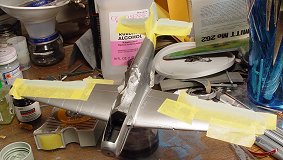 can tape right over the silver
without worrying about damaging the paint. Alclad surfaces are very
durable.
can tape right over the silver
without worrying about damaging the paint. Alclad surfaces are very
durable.
This is where it gets a bit
different than your normal way of putting a plane together. I put the
Hinomarus on at this time. You have to put the white disk down first and
set it up with your favorite setting solution. Let it fully dry then put
the red one over the top. Take your time and get the alignment perfect
before using any kind of
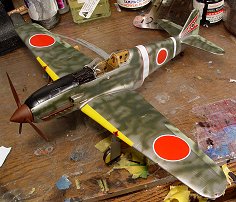 setting solution for the red part. Now it is time
to paint the “Palm Frond leaves” pattern. Use the diagram that came with
the AeroMaster decals. It is a good guide on how to apply the pattern. Some
use a paint brush and some use an airbrush. It is up to you how you want to
apply the camouflage pattern. I used Tamiya JA Green to replicate the camo.
Arguments have been made that 34092 European Green is a more accurate
color. When I used this color the Silver underneath made the green too
light. So I switched to the Tamiya paint. Once all was dry I masked off the
area for the yellow identification panels on the wing leading edge. You can
use Tamiya low adhesive tape directly onto the silver paint with no
problem. My preferred color for this is Model Masters Acryl Chrome Yellow.
Don’t forget that there is a small stripe on the wheel covers that needs
yellow also. So you need to mask off this area and hit it with yellow at
the same time. I then finished decking out the plane with the markings of
Lt. Yoshimitsu Tarnui of the 68 ACR, 2nd Company at NewGuinea/Hollandia
in April 1944 from AeroMasters decal sheet 48-133.
setting solution for the red part. Now it is time
to paint the “Palm Frond leaves” pattern. Use the diagram that came with
the AeroMaster decals. It is a good guide on how to apply the pattern. Some
use a paint brush and some use an airbrush. It is up to you how you want to
apply the camouflage pattern. I used Tamiya JA Green to replicate the camo.
Arguments have been made that 34092 European Green is a more accurate
color. When I used this color the Silver underneath made the green too
light. So I switched to the Tamiya paint. Once all was dry I masked off the
area for the yellow identification panels on the wing leading edge. You can
use Tamiya low adhesive tape directly onto the silver paint with no
problem. My preferred color for this is Model Masters Acryl Chrome Yellow.
Don’t forget that there is a small stripe on the wheel covers that needs
yellow also. So you need to mask off this area and hit it with yellow at
the same time. I then finished decking out the plane with the markings of
Lt. Yoshimitsu Tarnui of the 68 ACR, 2nd Company at NewGuinea/Hollandia
in April 1944 from AeroMasters decal sheet 48-133.
|
FINAL CONSTRUCTION |
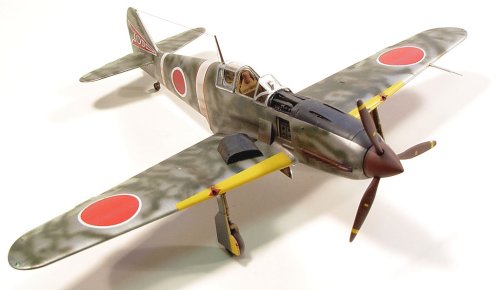 The rest of the plane was
just straight forward assembly. There are small intakes, coolers, gunsight,
pitot tube and other sundry items that need to be painted and put onto the
plane. The antenna got the same brown as the propeller and was superglued
into position. I used 2lb fishing line painted black for the antenna wire.
The tail wheel is a nice little unit and glues straight onto the fuselage.
The top of the engine cover got a dark black/blue color airbrushed onto it
and glued into place. I had to bend the photo-etch cowling into shape. Take
your time when doing this. The canopy is too thick to cut apart and poise
in the open position. I don’t know why Hasegawa molded it in one piece. But
it is clear and useable so I cut it apart and I used the forward section
and aft section of the kit glass and a Squadron Vac-u-form canopy center
section. To get the canopy to look good slid back in the open position you
have to use the thinner vac-u-formed canopy. It got trimmed out in silver
and glued on with Micro Krystal Klear.
The rest of the plane was
just straight forward assembly. There are small intakes, coolers, gunsight,
pitot tube and other sundry items that need to be painted and put onto the
plane. The antenna got the same brown as the propeller and was superglued
into position. I used 2lb fishing line painted black for the antenna wire.
The tail wheel is a nice little unit and glues straight onto the fuselage.
The top of the engine cover got a dark black/blue color airbrushed onto it
and glued into place. I had to bend the photo-etch cowling into shape. Take
your time when doing this. The canopy is too thick to cut apart and poise
in the open position. I don’t know why Hasegawa molded it in one piece. But
it is clear and useable so I cut it apart and I used the forward section
and aft section of the kit glass and a Squadron Vac-u-form canopy center
section. To get the canopy to look good slid back in the open position you
have to use the thinner vac-u-formed canopy. It got trimmed out in silver
and glued on with Micro Krystal Klear.
|
CONCLUSIONS |
The model didn’t give me any nasty surprises and was a very easy build even with the resin cockpit and gun bay. Watch those forward wing roots and you will do just fine. It looks great and really stands out on the shelf. I spent about 20 hours on this. You should have some experience with multimedia kits if you want to tackle the resin addition and photo-etch add-ons. I recommend this kit for all skill levels.
May 2003
|
REFERENCES |
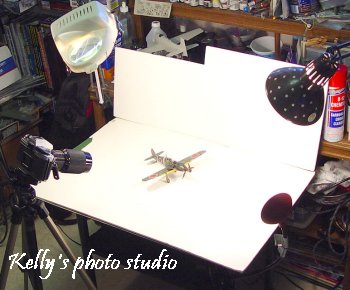 Squadron Vac-U-Form Canopy #9561
Squadron Vac-U-Form Canopy #9561
Eduard Model Accessories Seatbelts IJA 49 005
Aries Kawasaki Ki-61I Cockpit Set #4017
AeroMaster Decals Kawasaki Tony Ki61 I part II 48-133
Arco-Aircam Aviation Series No. 27 Kawasaki Ki.61/Ki.100
Osprey Aircraft Series #13 Japanese Army Air Force Aces 1937-45
Camera: Sony DSC-F707
If you would like your product reviewed fairly and quickly, please contact me or see other details in the Note to Contributors.